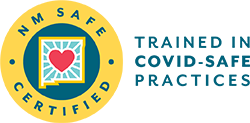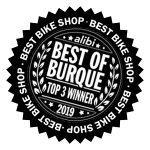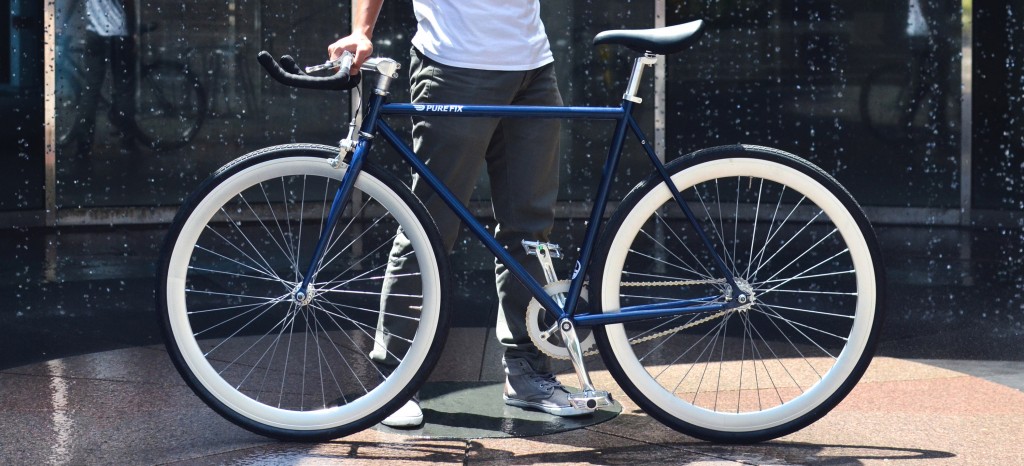
Biking is one of the most affordable and healthiest modes of transportation around. Commuting to and from the places you routinely travel is a convenient way to work exercise into your day and can be easier, more safe, and more fun than many people think. The best part? It’s not only cost effective but it’s easy to bike commute year-round in Albuquerque! If you’re used to getting around solely by car, though, there are a few steps to take to get yourself ready.
1. Decide what kind of bike you want
There are many types of bicycles, but for the most part bike commuting has three basic bicycle types: mountain, road, and hybrid. To decide which is best for you, consider where you’ll be riding and your purpose. Someone trying to get to work and back in the most comfortable way possible and someone using their commute as triathlon training will have very different needs.
If you’ll be riding on dirt trails or heavily potholed streets, consider a mountain bike for its shock absorption, wide tires, and extra-sturdy frame. For riding on streets, a road bike can be a good choice, as it will be lighter and faster on paved roads and more aerodynamic than a mountain bike. To see and be seen by traffic, consider a hybrid, which combines the upright posture of a mountain bike with the fast, lightweight qualities of a road bike. There are many more specialty bike types and subtypes, and you can read more about them with this straightforward guide or dive into Sheldon Brown’s exhaustive site.
Another favorite commuter bike is the ever-popular fixie, or fixed gear bike because of its fundamental simplicity. The cog on a fixie does not have bearings so it is directly tied to the motion of the pedals. Because of this, you’re much more a part of the bicycle than you are on a single speed cruiser or something of the like.
At Routes, you have the unique ability to “test-drive” all the main commuter styles of bikes with a quick half-day rental. In addition, we offer an assortment of bicycle types for purchase.
Keep in mind that you can customize the bike you do buy — by putting wider tires on a hybrid or bull-horn handlebars, for example — and that the nicer the bike, more susceptible to theft (see below for recommended accessories). Be sure to purchase the bike that meets your needs. At Routes, we will help you match bikes and accessories to your needs and budget.
And of course, if you already have a perfectly good bike, there’s no reason to buy a new one. Just bring your old one in for a tune-up starting at just $25 for a quick check, $49.99 for a standard, and $74.95 for a complete tune-up.
Even if you think the bike you have might not be quite right for commuting, riding it for a few weeks before buying a new one will give you an idea of what exactly you want instead. Also, make sure to get your bike professionally fit for you. It makes a huge difference in comfort, and we are happy to do it.
2. Obtain the basic accessories for Bike Commuting
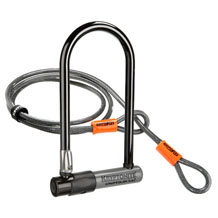
There are a lot of bike accessories out there, there are a few basics you need before you begin bicycle commuting. At the bare minimum, buy a helmet, front and back lights, and a lock (U-locks and bike chains are more secure than cable locks). And learn to how lock your bike up. For carrying stuff to and from work or going grocery shopping, consider a rear rack and panniers, which attach to your rear rack. They take weight off your back, which along with wearing a loose-fitting shirt has the benefit of reducing back sweat (always a plus). Look for panniers you’d feel comfortable carrying into your workplace.
Alternatively, bike baskets are convenient and attach to the front of your bike, so you can keep an eye on your purse or backpack as you ride. We sell both bike bags and baskets at Routes. If you have a long ride, or live in a hot climate, consider bringing a change of clothes for after the ride.
Some accessories aren’t optional. Albuquerque traffic code mandates that cyclists use a front lamp and rear reflector after sunset. Additionally, water and sunscreen are very important in Albuquerque. Always have them with you.
Optional-but-useful items include thorn-resistant tires and tubes as well as sealant in your tubes, which seals your inner tube after a puncture. They add a little weight to the bike but make up for it by defending against Albuquerque’s ubiquitous goatheads. You probably already have a cell phone, but make sure to carry it with you when you’re biking. If you get stuck with a flat tire you can’t fix, you’ll be able to call a friend or a cab to pick you up. There are some small repairs you may have to make on the road, and these situations call for a few items as well. Make sure you have a small hand pump and a tire patch kit.
Instead of piecing all the basics together yourself, let us help! Our Commuter Basics Kit has everything you need to get out on the road. It includes a water bottle filled with tire levers, a patch kit, a multi-tool, sunscreen, lip balm, a reflective band, a front light, and an Albuquerque bike map. The Commuter Kit sells for $30 but has a $40 value!
3. Educate yourself on bike safety
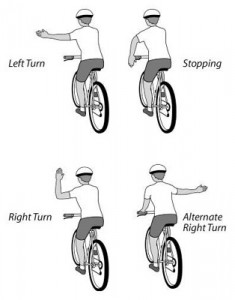 Here are the basics: wear a helmet, obey traffic laws, be visible, and be predictable. Many drivers aren’t used to driving around bikes and really don’t know what to expect from cyclists. Don’t make sudden, unexpected movements, and use hand signals before turning. There’s a lot more that will keep you safe, though. Did you know, for example, that claiming the lane is often safer than hugging the curb? In Albuquerque, drivers are required to leave at least five feet of space when passing a cyclist. If the lane isn’t wide enough for that and cars are squeezing past you at high speeds, it’s safer to take the lane so drivers will pass in the next lane. The space closest to the curb also tends to collect debris, including broken glass and screws, which can give you a flat tire. And don’t forget tumbleweeds — atmospheric in westerns, not your wheel spokes!
Here are the basics: wear a helmet, obey traffic laws, be visible, and be predictable. Many drivers aren’t used to driving around bikes and really don’t know what to expect from cyclists. Don’t make sudden, unexpected movements, and use hand signals before turning. There’s a lot more that will keep you safe, though. Did you know, for example, that claiming the lane is often safer than hugging the curb? In Albuquerque, drivers are required to leave at least five feet of space when passing a cyclist. If the lane isn’t wide enough for that and cars are squeezing past you at high speeds, it’s safer to take the lane so drivers will pass in the next lane. The space closest to the curb also tends to collect debris, including broken glass and screws, which can give you a flat tire. And don’t forget tumbleweeds — atmospheric in westerns, not your wheel spokes!
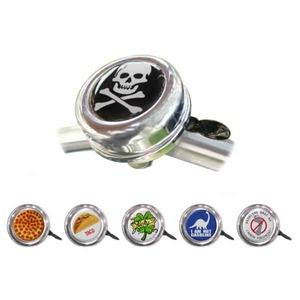 Bike safety isn’t just about cyclists and drivers, though. Some paths in Albuquerque, like the Bosque trail, are shared between cyclists, pedestrians, and even equestrians. Bikes are hard to hear coming, so call out “on your left” (because you should be passing on the left) before passing. Slow down, be prepared to brake suddenly, try not to pass within arm’s length, and be especially careful passing children and dogs, who often make sudden, unpredictable movements. It’s usually a good idea to add a bell to your bicycle to alert others when you are passing.
Bike safety isn’t just about cyclists and drivers, though. Some paths in Albuquerque, like the Bosque trail, are shared between cyclists, pedestrians, and even equestrians. Bikes are hard to hear coming, so call out “on your left” (because you should be passing on the left) before passing. Slow down, be prepared to brake suddenly, try not to pass within arm’s length, and be especially careful passing children and dogs, who often make sudden, unpredictable movements. It’s usually a good idea to add a bell to your bicycle to alert others when you are passing.
Follow the law, be proactive about your safety, and be considerate of drivers and pedestrians, and you’ll go a long way towards having a great commute.
4. Start riding
Your ride starts with planning and practice. Bike to a restaurant near your work to try routes, to the grocery store to practice carrying cargo, or in the Bosque to be around pedestrians. You’ll notice different things when biking vs. driving that will affect which streets you decide to take. You can start by looking up possible routes on Google Maps and in your city’s bike route map, and it is recommended to test the route before your first full day of commuting.
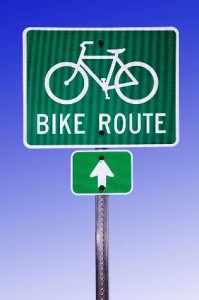 Quiet neighborhood streets, for example, may not be marked as bike routes but can actually be safer than being in a bike lane with cars flying past you. Here in Albuquerque, we have Bicycle Boulevards – which are streets where cyclists have the right of way and cars have to drive under 18 mph. Even though cyclists get the full lane, it is usually still recommended to ride to the right side of the street, unless going 18 mph. So do some research, but then get out there and find the best routes for yourself. And remember — cyclists have a legal right to ride on any public-access, non-highway roadway in the city, not only designated bike routes or bicycle boulevards.
Quiet neighborhood streets, for example, may not be marked as bike routes but can actually be safer than being in a bike lane with cars flying past you. Here in Albuquerque, we have Bicycle Boulevards – which are streets where cyclists have the right of way and cars have to drive under 18 mph. Even though cyclists get the full lane, it is usually still recommended to ride to the right side of the street, unless going 18 mph. So do some research, but then get out there and find the best routes for yourself. And remember — cyclists have a legal right to ride on any public-access, non-highway roadway in the city, not only designated bike routes or bicycle boulevards.
A great way to ease yourself into riding along-side cars is to take one of our bike tours, which both locals and tourists love. Many are beginner-friendly and all are a fun way to introduce yourself to street-riding safety.
5. Make it easy to ride
If you’re lying in bed every morning asking yourself if you’re going to bike or drive, chances are you’ll sleep in a little longer and drive. Even if you don’t bike every day, you can decide to bike on certain days of the week. Try to make bike commuting a habit you don’t have to think about. You can also remove obstacles to biking and add obstacles to driving. For example, prep everything you need for biking the night before but put your cars keys in a hard-to-reach place. Some people find it motivating to use a bike computer to keep track of miles traveled and calories burned, which can fit in well if you have other fitness goals.

You also don’t have to go from never bike commuting to doing a two-hour round trip five days a week. Take it easy at first. Build a resting point into your route, allow yourself time for a break, and remember there’s no shame in pushing your bike uphill. Additionally, all ABQRide buses have bike racks (here’s a video on how to use bus bike racks), and you’re allowed to take bikes on the Rail Runner, so you can take public transportation part of the way. A lot of people think they have to already be in good shape to get started, but most people can start where they are (short shorts are also optional). Cut yourself some slack and get started.
And — remind yourself why you’re biking. Every mile you bike saves you money, improves your health, and reduces your gas consumption. And biking’s fun!
If you have questions or are ready to start bike commuting, stop by our shop in Historic Old Town. We’d love to help!
More resources:
Local bike advocacy group: http://www.bikeabq.org/



